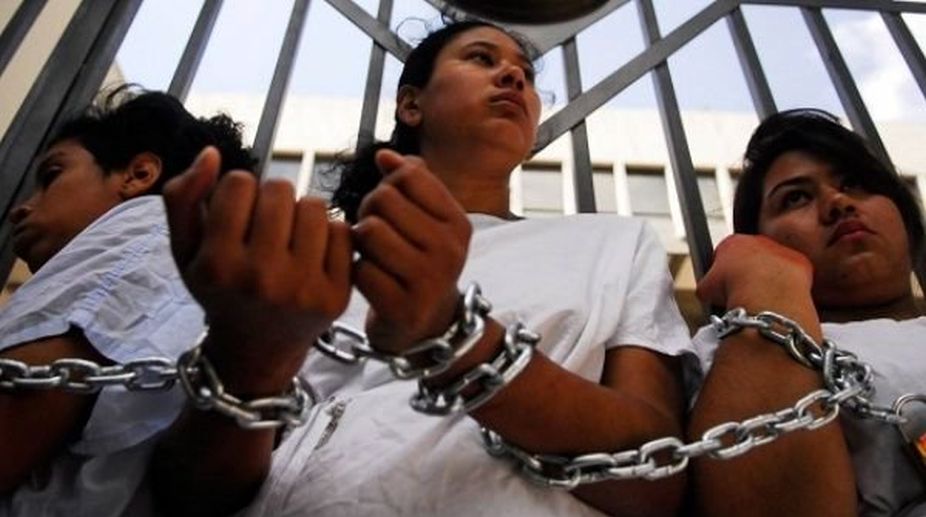The Supreme Court has observed that leniency can be shown to women criminals under certain circumstances. In a recent case, a woman, accused of mixing sedatives in drinks to help a man rob another of Rs 27,000, was convicted of the crime which carries a maximum sentence of ten years in jail.
But the Chamba (Himachal Pradesh) trial court, after taking into consideration that the woman had three small children, two of whom were mentally disabled, punished her with a sentence of two years in jail and imposed a fine of Rs 6,000. Even this punishment was erased after nine years. When the state appealed against the erasure of judgment, the Supreme Court observed that while the first sentencing by the trial court was in keeping with the spirit of showing leniency to female criminals, the subsequent complete erasure of the sentence was wrong.
Advertisement
But this goes against the very basis of law which decrees that all citizens, regardless of caste, creed, religion, gender and economic status are equal before law and all should be punished in a similar manner. There should not be – in fact cannot be – any discrimination in meting out punishment to a woman just because of her gender. If a woman commits a crime, she should be handed out the same punishment that would have been given to a man in similar circumstances. Extenuating circumstances cannot be cited to grant relief to a women criminal.
The reason for this is two-fold. Firstly, Indian laws do not have separate punishments for males and females. The Indian Penal Code (IPC) is clear in this regard. The terms used in the Act and the explanations given therein make it clear that the intention of the legislature was to treat every criminal at par, regardless of gender.
At the very beginning of the Act, in the chapter “General Explanations,” under gender it is said that “the pronoun “he” and its derivatives are used of any person, whether male or female.” Further, when it comes to distinction between genders, under man-woman, it is clarified that “the word “man” denotes a male human being of any age; the word “ woman” denotes a female human being of any age.” Hence, once again, the legislative intent to specify gender difference when necessary is made clear.
But the body of the Act does not make this difference when talking about crimes and punishment. Every section begins with either “whoever” or “a person”. Both these terms are gender-neutral. “Whoever” and “a person” can either be a man or a woman and the punishment prescribed is to be applied equally in either case. Lastly, the chapter on “general exceptions” too does not make any exceptions for crimes committed by females and the punishment to be given for the same. So for courts to discriminate in favour of women criminals would be judicial overreach.
Secondly, if a woman is to be shown leniency in case she has young children to look after, cannot the same logic be applied for a male offender to say that he is the sole earning member of the family? In the instant case, leniency was shown to the female criminal as she had three children, of whom two were mentally unstable, to look after themselves.
But what if the roles were reversed and it was not the woman who committed the crime but her husband, who was the sole earning member of the family? If the husband was put in jail for ten years, how would the women look after her children in any case? If the court is concerned about what will happen to the children if their mother is sent away to jail, it should also be worried how the mother will feed the children if the husband, who provides for the family, is sent to jail.
One thinks that the judicial view of showing leniency towards female convicts is guided by a similar view in England, from where most of our laws have evolved. In 2010, the Judicial Studies Board (JBS), a body in England that trains judges, quoted Supreme Court judge Baroness Hale as saying that “It is now well recognised that a misplaced conception of equality has resulted in some very unequal treatment for women and girls.”
JBS, in Equal Treatment Bench Book, was of the view that female criminals are more likely to have mental health or educational difficulties and to have parenting responsibilities, while a lower proportion will have committed violent crimes than men. Judges were advised to “bear these matters in mind” when passing sentence under new guidelines.
But the Indian scenario is different. In the UK, the female might be an earning person who supports her children out of her own income. She could even be a single mother. In India, an overwhelmingly large number of women do not earn on their own but are dependent on the income of the husband to run the household. Their parenting difficulties will be insurmountable if their criminal husbands are put into jail, as there would be no income to support the children. Could that be a ground to show leniency to male criminals?
In any case, before that, in 2009, the Telegraph newspaper in UK had reported that there was a sharp rise in conviction and punishment of female criminals. There was a jump of 10 per cent in two years. Women were getting involved in crime and abetment to crime in larger numbers. There is a similar trend in India. While the Indrani Mukherjea case is still hogging limelight, there are numerous cases of hard crimes committed by females that do not make front page news for the simple reason that the perpetrators are not celebrities. But the fact remains that an increasing women in India are being accused of crime and a large number of them are being convicted for the same. In such a scenario, showing leniency to them is neither warranted by law nor is it a socially or morally correct thing to do.
There can be mitigating circumstances in many cases and judges mostly apply their discretion in showing leniency depending upon the facts of the case. But to make it gender-specific is wrong. Women criminals are in no way different or softer than men criminals. With more and more women getting drawn towards the criminal way of life, either independently or lured by their male acquaintances, there is no need to make them believe that they will be treated with kid gloves by the law. It will embolden them and attract newer recruits. Hence, the law must be applied equitably and justly for both the genders. There should not be any exceptions on just the basis of gender.
The writer is Editor-in-Chief, www.indiacommentary.com











